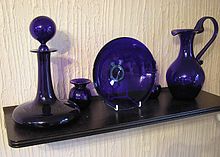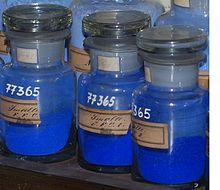Cobalt glass
| Smalt | ||
|---|---|---|
| (26, 74, 261°) | ||
| Source | ColorHexa[1] | |
| B: Normalized to [0–255] (byte) | ||

Cobalt glass—known as "smalt" when ground as a pigment—is a deep blue coloured
Cobalt glass plates are used as an optical

Moderately ground cobalt glass (potassium cobalt silicate)—called "smalt"—has been historically important as a pigment in glassmaking, painting, pottery, for surface decoration of other types of glass and ceramics, and other media.[4][5] The long history of its manufacture and use has been described comprehensively.[6] Cobalt aluminate, also known as "cobalt blue",[7] can be used in a similar way.
Cobalt glass such as

History
The earliest known example of

The invention of a European smalt process has traditionally been credited to a Bohemian glassmaker named Christoph Schürer, around 1540–1560.[13] However, its presence in Dieric Bouts' The Entombment from circa 1455 proves that it was used at least a century earlier.[14]
In England and Scotland, smalt was added to laundry starch. James VI and I considered awarding a patent for making a "blue azure" product for this purpose in Scotland in February 1609.[15]
The process used for producing cobalt smalt glass at the Blaafarveværket industrial manufacturing center in Norway in the 19th century has been documented as smelting cobalt oxide together with quartz and potassium carbonate. The result was an intensely blue glass-like substance that was ground and sold to producers of glassware and porcelain.[16]
Notes
- ^ "Smalt / #003399 hex color (#039)". ColorHexa. Retrieved 2022-12-22.
- ^ Glass Plates, Cobalt, Flinn Scientific
- ^ [1], Olive Oil Times
- ^ a b "The Changing Properties of Smalt Over Time". Tate. Retrieved December 26, 2020.
- ISBN 0-900682-06-X
- ISBN 9788882863418.
- ^ "Cobalt". Encyclopædia Iranica. Retrieved December 26, 2020.
- ^ a b Encyclopedia Iranica, "Cobalt"
- JSTOR 4629297.
- ^ Jules Marie J. Guiffrey; Léon Emmanuel S.J. Laborde (marq. de) (1877). J.M.J. Guiffrey (ed.). Les comptes des bâtiments du roi, 1528–1571. Suivis de documents inéd. sur les châteaux royaux et les beaux-arts au XVIE siècle, recueillis par le marq. L. de Laborde (in French). Paris. p. 96. Retrieved 6 November 2010.
{{cite book}}: CS1 maint: location missing publisher (link) - ^ See: (1) Mauro Bacci and Marcello Picollo, "Non-Destructive Spectroscopic Detection of Cobalt(II) in Paintings and Glass," Studies in Conservation, vol. 41, no. 3, pages 136–144 (1996); especially page 136; and (2) C. Altavilla and E. Ciliberto, "Decay characteristics of glassy pigments: an XPS investigation of smalt paint layers," Applied Physics A, vol. 79, pages 309–314 (2004); especially page 309.
- ^ See also: Bruno Mühlethaler and Jean Thissen, "Smalt," pages 113–130 in Ashok Roy, ed., Artists' Pigments: A Handbook of Their History and Characteristics, vol. 2 (Oxford, England: Oxford University Press, 1997).
- ISBN 978-0-486-21597-6. Retrieved 6 November 2010.
- ^ B. Mühlethaler and J. Thyssen, "Smalt", In : A.Roy [ed.], Artist's Pigments: A handbook of Their Characteristics, volume 2, 1993, p. 113-130
- ^ David Masson, Register of the Privy Council of Scotland, 1607-1610, vol. 8 (Edinburgh, 1887), p. 559.
- ISBN 978-82-90734-20-1. Retrieved 6 November 2010.
Further reading
- An Archaeometallurgical Explanation for the Disappearance of Egyptian and Near Eastern Cobalt-Blue Glass at the end of the Late Bronze Age, Jonathan, R. Wood and Hsu Yi-Ting, 2019, Internet Archaeology 52, Internet Archaeology
- Smalt, Bruno Mühlethaler and Jean Thissen, Studies in Conservation, Vol. 14, No. 2 (May, 1969), pp. 47–61, JSTOR
External links
- Smalt Pigments through the Ages
- Bromo-Seltzer: Cobalt Blue bottles - Brief Summary
- "M inside a circle" trademark: Maryland Glass Corporation, Baltimore (prolific producer of cobalt blue glass containers)
- An Archaeometallurgical Explanation for the Disappearance of Egyptian and Near Eastern Cobalt-Blue Glass at the end of the Late Bronze Age Internet Archaeology
